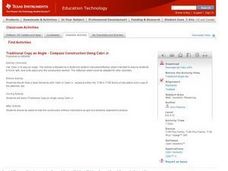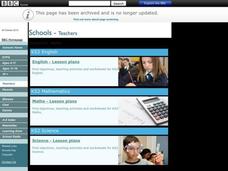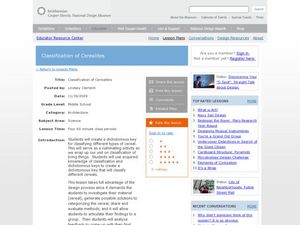Curated OER
Circles all Around
Middle schoolers investigate circles. In this middle school mathematics lesson plan, students explore the relationship between the diameter of a circle and its circumference.
Curated OER
Dimensions and Area
Learners explore the area of rectangles in this middle school geometry lesson. They will investigate the relationship between a change in the dimensions of a rectangle and the change in the corresponding area. Learners also investigate...
Texas Instruments
Traditional Copy an Angle - Compass Construction Using Cabri Jr.
Learnerss explore geometric construction in this geometry lesson. They will investigate the traditional construction for copying an angle using Cabri Jr. in lieu of paper and pencil construction. The lesson encourages learners to explore...
Texas Instruments
What's the Scale?
Pupils will analyze scales as related to models and real life in this geometry lesson. They work together to compare the dimensions on a model as compared to the real building.
Curated OER
Count Them Up
Pupils calculate area using the geoboard application on their calculators. They use a TI-73 calculator to find the areas of the shapes provided in the accompanying worksheet. Screen shots and instructions for creating shapes in the...
Curated OER
Percentages
Students examine the concept of percent and calculate percentages of one hundred and convert them into fractions and decimals. They view and discuss a one hundred square grid and identify percentages. Students design a playground...
Curated OER
Volume
In this volume worksheet, students participate in an experiment to test the volume in a few food containers. Students complete an experiment and then answer six comprehension questions regarding the results of their experiment.
Curated OER
Madley Brath #39 - Stem and Leaf Plots, Mean, Median, Mode and Range
In this measures of central tendency worksheet, students draw a stem and leaf plot of a set of test scores. They compute the mean, median, mode, and range of the data set, and round the answers to the nearest tenth.
Curated OER
Filling the Glass (Water, Air, and Fractions)
Students predict which of two glasses is 1/2 full using visual estimation, height measurement, and liquid measurement methods. Mathematical equations to accurately solve the problem are determined and verified.
Curated OER
Understanding Biodiversity Via Ecological Footprints
Sixth graders investigate the ways in which human beings impact the environment and ecology through the calculation of their own ecological footprint, discussion questions pertaining to biodiversity and potential imbalance hazards, and...
Curated OER
Fraction Fun
In this fraction practice worksheet, young scholars use a matrix of different noises found in 5 towns. Students determine what fraction of the towns are experiencing noise problems and write the fraction for each town.
Curated OER
By the Pound, Gram Liter or Gallon
Students participate in experiments at five stations to practice measurement. In this measuring lesson, students are presented different produce and objects and must measure with an appropriate tool. Students use metric and customary...
Curated OER
Rainforest Unit
Students investigate the Rainforest. In this Rainforest lesson, students research magazines, journals and the Internet to create a "Save the Rainforest" slogan. Students will record local rainfall amounts and create a graph comparing...
Curated OER
The Great Pollinators
Students discover the reproductive parts of a plant. In this biology lesson, students identify and categorize several different plants they dissect in class. Students record their information using a data chart.
Curated OER
How do living and non-living structures affect coral reef habitats?
Students create model coral reefs showing surface area and including examples of communities. In this coral reef lesson, students research and explore the functions or benefits from a coral reef. Students design a benthic...
Curated OER
Classification of Cerealites
Students create a dichotomous key. In this categorizing activity, students create a dichotomous key for different types of cereal. Students classify the cereal into groups such as flakes and cereal with holes. Students discuss their...
Curated OER
Explore the Ocean
Students explore the oceans from their origin. In this oceans lesson, students read and discuss excerpts from the Book of Genesis regarding the creation of the ocean. Students then clean up a mock oil spill, measure the volume and area...
Curated OER
Polar Bear Panic!
Students identify the three realms of the Arctic Ocean, and describe the relationships between these realms. They graphically analyze data on sea ice cover in the Arctic Ocean, and recognize a trend in these data.
Curated OER
Dr. Dirt's Archaeology Lab Artifact Analysis
Learners simulate analyzing artifacts in archaeological lab by using real techniques that archaeologists use. Students practice measuring skills, drawing, writing, and brainstorming, and make inferences based on evidence.
Curated OER
Does Clear Water mean Healthy Water?
Learners test their local aquatic site to determine its water clarity. They collect a water sample and measure its turbidity using a sensor, then they repeat the experiment to obtain a second turbidity reading to find the average value.
Curated OER
Match Me!
Young learners explore motion graphs in this lesson. They investigate distance-time plots as they move in a specific way in front of the CBR in an attempt to make a motion plot that matches a given plot. Pupils explore the connections...
Curated OER
How Far Did They Go?
Students create a map. In this direction and distance lesson, students come up with familiar places in the community and calculate the distances from these places to the school. Students create a map that displays these places and their...
Curated OER
Collect Data Using a Transect Line
Students learn about transect lines through a study of marine debris. In this marine debris instructional activity, students calculate the items on a transect line and graph them. Students complete a category worksheet.
Curated OER
The Mathematical Implications of Lying
Students explore how statistics can be interpreted in different ways. In this probability lesson students complete a class lab activity then discuss their findings.
Other popular searches
- Math and Science Careers
- Integrated Math and Science
- Science and Math
- Science/ Math Games
- Math and Science Activities
- Integrating Math and Science
- +Math and Science Careers
- Math and Science Plan
- Math and Science Lessons
- Word Origins Science Math
- Math in Science Experiments
- Science Math























